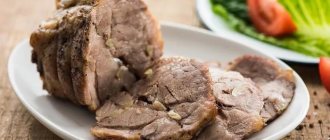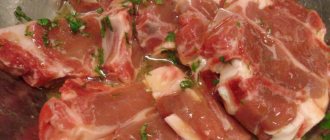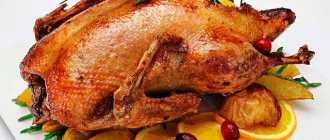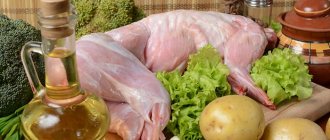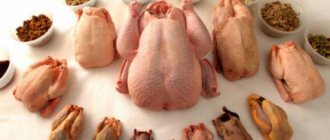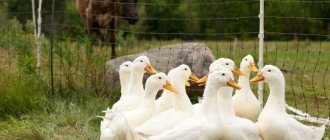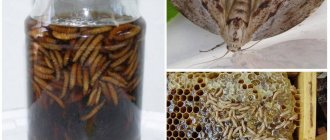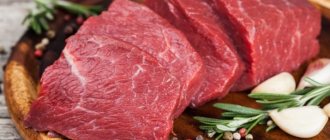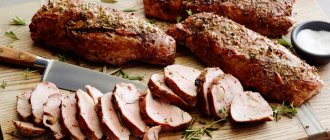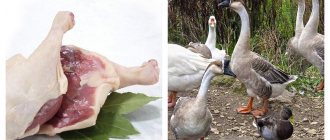Beef is called marbled beef, in the thickness of which there are thin veins of intramuscular fat. When cut, this meat resembles the pattern of real marble. This is where the name came from.
Marbled beef is a gourmet meat. The uniform distribution of fat throughout the muscle tissue makes it unusually juicy and soft. According to the Japanese, marbled beef is meat for those who have no teeth. The exquisite appearance, juiciness and softness of marbled beef make it possible to use it when preparing cuts of raw meat - tartare and carpaccio.
History of origin
The first to raise marbled cattle were in Japan. Information about it first appeared in the 17th century. At that time, ordinary Japanese did not have the right to eat animal meat, but bulls of a special breed of wagyu were raised in order to feed warriors and the sick as directed by a doctor [1]. These were the few herds in the Matsuzaki Valley. The rearing of these bulls on an industrial scale was allowed only after the young Emperor of Japan Mutsuhito lifted the ban on eating beef in 1868 [2].
In addition to the Wagyu breed, marbled beef is obtained from other breeds of cattle - Aberdeen Angus, Hereford, Aquitaine. The main modern producers of marbled beef from these breeds are the USA, Australia, Argentina, New Zealand and Japan [3]. In recent years, bulls have begun to be reared en masse to produce marbled beef in Russia, for example, the Miratorg agro-industrial farm, which has a large population of Aberdeen-Angus bulls [4].
Content:
- History of origin
- How livestock is raised
- Degrees of marbling
- Chemical composition
- Beneficial features
- Possible harm
- How to choose and store correctly
- Use in cooking
- conclusions
Among reputable culinary specialists, it is believed that the Wagyu breed is the most suitable for producing marbled meat. Moreover, the most proper marbled beef is considered to be the meat of bulls raised in the vicinity of the city of Kobe in Japan, which is called “Kobe beef” [5]. This is marbled beef of the highest quality, the price of which per kilogram can range from 200 to 700 dollars.
Aberdeen Angus breed
How is an animal raised for marbled beef? First of all, you need to choose the right breed of cow. Not all varieties of gobies are suitable for these purposes. One of the most popular breeds with a high degree of marbling is the Aberdeen Angus. The appearance of fatty layers is due to the genetic characteristics of animals.
Black gobies have rather short but strong limbs. The height of males on average is 150 cm, females - 130. An adult bull reaches a weight of 1 ton, the body weight of a cow is 200 kg less. It is believed that the optimal slaughter age for representatives of this breed is 18 months. If you do this later, the muscle fibers will become coarser and the marble pattern will become blurred. Representatives of the Aberdeen Angus breed are kept freely.
How livestock is raised
Gourmet meat cannot be cheap. The high cost of marbled beef is due to two factors: the complexity and duration of raising cattle.
In Japan, calves are fed milk from birth until six months. Grown calves are grazed freely in the meadows. Several months before slaughter, bulls are suspended on belts so that they move less and do not lie down. At this time, they are fed a high-calorie mixture of barley, corn, alfalfa and wheat straw.
Since animals are reluctant to eat in the humid and hot climate of Japan, they are fed beer. During this rearing period, the bulls are massaged to classical Japanese music. It is under such conditions, according to the Japanese, that marble veins are formed in meat.
The minimum duration of raising Wagyu bulls to produce high-quality marbled beef is 30 months. The gold standard for the duration of grain feeding before slaughter is 200-300 days.
Hereford breed
We will look at how to grow marbled beef a little later. For now, we continue the story about the breeds that are best suited for obtaining this delicacy. One of them is Hereford.
Short animals (approximately 125 cm at the withers) have a muscular body. They are kept on pastures. Representatives of this breed are distinguished by good cold resistance, but at low temperatures they are still placed in closed pens. Animals are taken to slaughter at the age of 19-20 months, having previously been fed cereals and hay.
Degrees of marbling
The cost of marbled beef depends on the degree of marbling. The more small grains and veins of fat in the muscle, the higher the degree of marbling [6]. In Japan, there are five categories of marbled meat:
- fifth category - marbled meat of the highest quality, which only goes to elite restaurants in Japan;
- the fourth and third categories are soft, darkish marbled meat, which is often purchased by European and Asian restaurants;
- the second and first categories are the most affordable Kobe beef. Due to the fact that marbled meat of similar quality from Argentinean and Australian producers is cheaper, Japanese beef of these categories is not in great demand among restaurateurs.
In the USA, there are also five categories of beef marbling: prime, choice, select, standard, commercial, which differ in accordance with clearly formulated criteria [7]. For the national American dish (steaks), only the first three categories of marbled meat are suitable. At the same time, the highest quality of them is prime category beef. In Australia, marbling is classified into 9 categories, with the ninth category being the highest quality.
What was the situation with marbled beef in the Soviet Union?
There is an opinion that one of the first statesmen to become interested in it was N.S. Khrushchev. During his official visit to the United States, he had the opportunity to taste a surprisingly aromatic beef steak. Khrushchev liked the taste of this dish so much that, upon returning home, he asked his chef to conduct a gastronomic experiment. And then a surprise awaited everyone. It turned out that the recipe for preparing the dish did not play a primary role. Much more important was the type of meat from which such a steak was made.
But the necessary beef was simply not found in the USSR at that time. Therefore, the Secretary of State had to open a special farm, where special beef bulls were imported from abroad.
Chemical composition
Marbled beef is rich in fats, proteins and contains virtually no carbohydrates. The calorie content of this meat is low - 170 kcal/100 g, which classifies it as dietary meat products.
The meat has a soft and juicy taste due to its moderate fat content (up to 10 g per 100 g of raw product) [8]. At the same time, this fat contains few saturated fatty acids - about 3.5 g, which is only 30% of their total amount. Marbled beef also contains a small amount of cholesterol - 40 mg per 100 g (for comparison, lean beef - 57 mg).
The bulk of intermuscular fat is represented by unsaturated fatty acids, including those from the omega group (omega-3 and omega-6) [9]. Their presence allows marbled beef to be consumed even by people at high risk of developing atherosclerosis and cardiovascular diseases [10].
Beef protein (18 g/100 g) is complete.
It contains all the amino acids necessary for the human body. In addition to nutrients, marbled beef contains many vitamins and minerals [11]. Vitamin composition
| Name | Content per 100 g, milligrams |
| Vitamin B1 (thiamine) | 0,085 |
| Vitamin B2 (riboflavin) | 0,131 |
| Vitamin B4 (choline) | 89,8 |
| Vitamin B5 (pantothenic acid) | 0,618 |
| Vitamin B6 (pyridoxine) | 0,637 |
| Vitamin B9 (folic acid) | 0,012 |
| Vitamin B12 (cyanocobalamin) | 0,0016 |
| Vitamin PP (nicotinic acid) | 6,42 |
| Vitamin E (alpha tocopherol) | 0,33 |
| Vitamin K (phylloquinone) | 0,0013 |
Marbled beef is a source of the vitamin-like substance choline, which is also known as vitamin B4. 100 g of this meat contains up to 20% of the body’s daily requirement for this substance. Choline, in combination with other vitamins, takes an active part in metabolic processes throughout the body, and also affects the functioning of the parasympathetic part of the autonomic nervous system, since it is a precursor of acetylcholine, a mediator of impulses in nerve endings.
Cyanocobalamin stimulates hematopoietic function, being an antianemic vitamin. By restoring normal intestinal microflora, vitamin B12 improves immunity.
Nicotinic acid is useful for people suffering from cardiovascular diseases and cerebrovascular disorders.
Mineral composition
| Name | Content per 100 g, milligrams [12] |
| Potassium | 340,0 |
| Phosphorus | 207,0 |
| Sodium | 58,0 |
| Magnesium | 23,0 |
| Calcium | 20,0 |
| Iron | 1,81 |
| Zinc | 3,98 |
| Copper | 0,094 |
| Manganese | 0,013 |
| Selenium | 0,026 |
This type of meat contains a lot of phosphorus, a chemical element that is part of many enzymes, hormones, proteins and phospholipids of the cellular framework. Iron is contained in marbled beef in a bioavailable, easily digestible form.
The benefits of marbled veal
Beef is a natural, environmentally friendly product. The bulls are fed a balanced diet and walked in the fresh air. Their meat contains a large number of useful substances:
- improving the functioning of the gastrointestinal tract - biotin, extractive nitrogenous substances, pantothenic acid;
- strengthening the immune system - conjugated acid;
- accelerating metabolism - choline;
- stimulating hematopoietic processes - cyanocobolamin;
- regulating hormone levels - phosphorus.
Eating “marble” culinary products helps replenish the body with vitamins B, E, K and minerals (zinc, magnesium, copper and others), helps reduce heart rate, and supports and normalizes the functioning of the nervous system. However, excess red meat can cause kidney disease, arthritis, and osteochondrosis.
Beneficial features
Due to its balanced chemical composition and moderate calorie content, marbled meat has a positive effect on the human body. It is recommended to use:
- heart patients (reduces cholesterol levels in the blood, normalizes heart rate, dilates peripheral blood vessels);
- neurological patients (improves cerebral circulation, accelerates reaction speed, restores impaired transmission of nerve impulses);
- for anemia (stimulates hematopoiesis, increases the level of hemoglobin in the blood);
- to restore the body after injuries, operations, burns, severe infections (increases immunity, stimulates reparative processes in the body);
- with hormonal dysfunctions (insufficiency of hormones of the hypothalamic-pituitary system, diabetes mellitus, dysfunctional sexual disorders);
- pregnant women and children (enriches the body with nutrients, vitamins, macro- and microelements) [13].
There is no scientifically substantiated evidence of the anti-carcinogenic properties of this type of beef, however, there is information in the literature that marbled meat has anti-cancer properties. This effect is probably due to the presence in meat of a large amount of vitamins that improve hematopoiesis and enhance immunity, which is important for cancer, especially after chemotherapy or radiation therapy.
Grazing
Representatives of meat breeds are used to produce marbled beef. They are distinguished by their endurance and are able to travel long distances in search of food. Therefore, one of the most important stages in the production of an expensive delicacy is grazing animals. It is carried out before fattening, as it allows bulls to gain muscle mass. For grazing, you need to prepare a spacious pasture with healthy herbs.
Possible harm
A high-quality and fresh product cannot cause harm. However, marbled beef, in addition to its high taste and beneficial properties, can be harmful under some conditions.
The possible harm of this type of beef is due to its high protein content. Protein molecules are a source of purine bases, an increase in the level of which can provoke an attack of gout, renal colic or pain in the spine due to osteochondrosis.
Fatty meat can cause exacerbation of diseases of the digestive system (pancreatitis, cholecystitis). Extractive substances contained in marbled beef increase the secretion of digestive juices, so eating it can cause an exacerbation of gastric and duodenal ulcers.
Contraindications to eating marbled meat are individual intolerance and allergies.
Features of cultivation
So, how are cows raised for marbled beef? It is very important to properly care for animals. Throughout the year they are kept free-range, allowing them to be in an environment close to natural. There they feed on meadow grasses and gain strength.
Then, approximately 3-4 months before slaughter, they are transferred to feedlots. During this time, the animals eat a special cereal mixture, the main ingredient of which is wet corn. At the same time, cows and bulls are restricted in their movement. We briefly looked at how to raise marbled beef, now we will dwell in more detail on the main aspects of this process and list the factors that affect the marbling of meat.
How to choose and store correctly
Marbled beef is a delicacy product. It is rarely available in butcher shops like other types of meat. In order not to be deceived and buy real marbled beef, you must:
- Buy it only in large stores or supermarkets.
- Consider the cost. The price of marbled meat cannot be less than $25 per 1 kg. Meat from bulls raised in Russia can cost less (from 1,900 rubles).
- Buy only pieces of meat packed in vacuum film. The marble pattern should be visible, so preference should be given to transparent and intact packaging.
- Carefully study the manufacturer's label. It must indicate what breed of bull the meat was obtained from, where and when it was produced, the degree of marbling, and what ripening method was used.
Meat ripening
Real marbled beef is not sold immediately after the animals are slaughtered: it needs to mature [7]. During the ripening process, the muscle fibers soften and the aroma and taste of the meat increases. There are two ways to ripen beef: dry and wet.
During dry ripening, meat (usually with skin) is hung in refrigerators and kept at temperatures from +1⁰С to +4⁰С for 15-28 days. After ripening, the meat is cleaned of skin and subcutaneous fat, divided into cuts and packaged under vacuum.
In wet aging, the bled beef is cooled to zero degrees and vacuum packed. Subsequently, it is kept in a refrigerator for 10-21 days.
Price
The cost of this type of meat differs depending on where it is purchased. You can buy marbled steak at the market, in the supermarket and even on the Internet. Let's imagine the average prices for the product in Moscow:
| type of product | Weight | Cost in rubles |
| Thick edge on the bone, back cut, frozen | 800 g | 1500 |
| Chilled ribeye piece | 900-1000 g | 2300 |
| Angus Striploin chilled, Miratorg | 500-900 g | 1550 |
| Chilled thigh pulp, boneless, Primebeef | 950 g | 900 |
| Miratorg Ribeye PRIME thick edge 7 ribs chilled | 5 kg | 3200 |
Use in cooking
Marbled beef can be prepared in different ways: fry in a frying pan, grill, boil, stew, bake in the oven. Most often it is used for cooking steaks.
Americans consider marbled beef the ideal meat for steaks: this meat makes them juicy and soft. The method and recipe for their preparation depends on the thickness of the cut used for the steak. There are four types of marbled meat cuts for steaks: tenderloin (sirloin), ribeye (thick edge), striploin (thin edge) and T-bone (T-bone).
Cooks distinguish 6 degrees of roasting of steaks, which differ in the juiciness of the meat and the temperature inside it after frying:
- raw steak (“blue-rea”);
- with blood (“rea”);
- medium-raw (“medium-rea”);
- medium rare (“medium”);
- almost cooked (“medium-vel”);
- fully fried (“vel-dan”) [14], [15].
The first and last degrees of roasting are not used when preparing steaks from marbled meat. It is believed that such delicate meat should be undercooked. In order for the juices to remain inside the steak, the meat must be “sealed”, that is, fried on both sides at a temperature of 220-250°C for 1.5-2 minutes on each side. As a result, a crust forms on the surface of the piece of beef, which prevents it from drying out during frying.
Next, the steak is brought to readiness at a temperature of 170-180°C. Cooking time depends on the desired degree of doneness. Once cooked, cover the steak with foil and let it rest on a hot plate for a few minutes.
In addition to steaks, many other dishes are prepared from marbled beef: in Japan - sashimi, shabu-shabu, sukiyaki, in Europe - carpaccio, tartar, roast. Steaks and dishes made from this meat are combined with olive oil, herbs (basil, thyme, rosemary), grilled vegetables (tomatoes, eggplants, sweet peppers, mushrooms), fruits (peaches, apricots, raisins, dried apricots) and fruit purees, berries sauces. Red wines highlight the delicate aroma and taste of steaks well.
Wagyu beef
This is one of the most expensive varieties of beef, which is why it is prepared in a special way:
- Heat the frying pan very high and add a knob of butter.
- Add the steak and cook for 1 minute on each side.
- Cut into small pieces.
